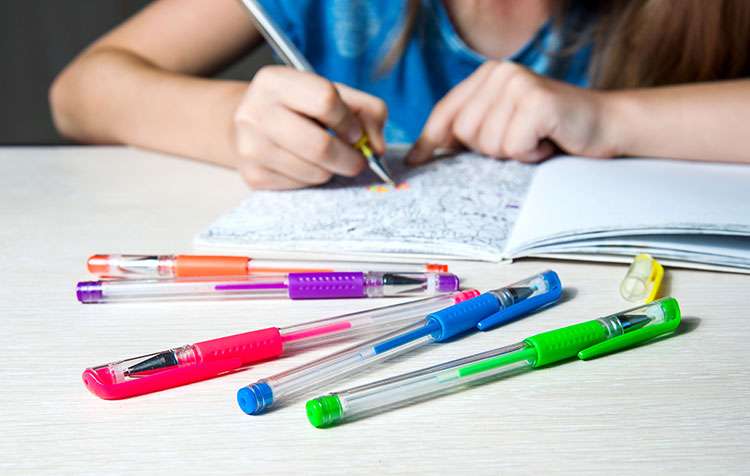By Clara Keane | May 11, 2017 | Children | Education
BACK TO THE MAIN BLOG

During the month of May, starting with the kickoff event on National Children’s Mental Health Awareness Day with the Substance Abuse and Mental Health Services Administration (SAMHSA), the AATA is highlighting topics related to children’s mental health in Art Therapy Today. Children benefit from art therapy in a variety of ways: for example, children with autism often find art a viable way to communicate; children with attention deficit disorders show improved ability to focus; children in cancer wards are soothed by art therapy. The list goes on and on.
 However, art therapy is not only beneficial to children with special needs. One way to make art therapy accessible to every child is to bring it to the schools. An AATA staff member took the opportunity to interview an expert in the setting of school-based art therapy, both in the classroom and in program design, to discuss how children can use art therapy to reconcile and process the chaos of both the outside world and their internal selves.
However, art therapy is not only beneficial to children with special needs. One way to make art therapy accessible to every child is to bring it to the schools. An AATA staff member took the opportunity to interview an expert in the setting of school-based art therapy, both in the classroom and in program design, to discuss how children can use art therapy to reconcile and process the chaos of both the outside world and their internal selves.
Marygrace Berberian, LCAT, ATR-BC, LCSW is a Clinical Assistant Professor with the Graduate Art Therapy Program and Director of the NYU Art Therapy in Schools Program at New York University. Marygrace has established school based art therapy initiatives throughout New York City for at-risk children and families for almost 20 years. Currently, Marygrace is leading the advocacy efforts for the inclusion of creative arts therapies in public schools in New York State and is a doctoral student in Creative Arts Therapies at Drexel University. We asked Marygrace four questions about her work with children in the school setting. This is what she said:
Q1: How do school-based art therapy programs in public schools benefit the community?
A1: When a student struggles cognitively, emotionally, or behaviorally, schools are often the first to identify symptoms and are then charged to deliver intervention. Accessing mental health services is often too daunting and cost prohibitive for overwhelmed, at-risk families. School facilities are more often becoming the sole providers of mental health support.
Art Therapy services in schools have effectively responded to the diverse and ever changing needs of students. Students have been aided by the capacity of art making to restore healthy functioning and provide mastery amidst feelings of helplessness. Art therapy presents an effective means to address these issues since students are offered an outlet to channel their anxiety and aggression into the art making process. The symbolic images that are generated allow students a capacity to express feelings and ideas regarding psychological conflicts and life experiences that are too emotionally loaded for verbal communication. When these issues are explored in the initial phase of treatment, there are usually more critical issues underlying the manifestations being observed in the school environment. Students are often discovered silently struggling with anxiety, depression, social difficulties and low self-esteem. Art helps students organize the chaos of their internal worlds and their often less than favorable realities.
As the students are a “captive” audience, treatment can be consistent and long term. Further, the art therapist can serve as the bridge between parents and teachers, fostering a more comprehensive and inclusive perspective on progress and the existing impediments. The seamless integration of art therapy services with other school services supports the students, teachers, and families to overcome obstacles and restore functioning.



Q2: How do images help children understand and communicate their experience of the world around them?
A2: Creating art promotes sequential reasoning and organization of thought for those faced with overwhelming feelings but lacking the coping mechanisms to properly process them. This can be incredibly burdensome for children. I vividly recall my observations of children after the events of 9/11. Art was often the only way children could make sense of the insensible. Art can serve as a way to map pictorially that which cannot be examined verbally. Order can be visually established in the midst of psychological chaos. Art making aids in affect regulation and can transform a child in distress into an engaged artist. More recently, children are trying to understand the division in their classes and families. Loyalties are being questioned and anxieties are triggered amidst that uncertainty. Notably, more discussions in sessions echo themes of “us” versus “them”. The identity of the enemy “them” is interchangeable to whoever threatens their sense of safety. More children are hyperaroused and vigilant to protect their own vulnerabilities.
Q3: Given the current political climate, how can art help children communicate their anxieties to adults?
A3: Concretizing internalized feelings through art production can become a starting point for discussion and provide a visual record for further discussion. It is important for adults to empathetically respond to the child’s anxieties as evident in their narratives and images. Creating a safe and contained space (both visually and dynamically) will usher more authentic expression. A simple bordered paper gives the paper some visual containment. For older children, polarity drawings often help to highlight differences and similarities in opposing perspectives.


Q4: How can art therapy help develop empathy and possibly limit bullying in the school system?
A4: Art, in its continuum from more controlled to less controlled expression, can allow for experimenting in ways to cope with adversity. In the safe confines of the treatment relationship and through non-verbal expression, children can rehearse alternative paradigms of relatedness. The empowering quality of the non-verbal, creative process, a key underpinning of our work as art therapy professionals, enables clients to “visually speak” their expression, thereby mediating and containing their internalized struggles. Often, the bullied child creates scenes where he is a fiercely courageous superhero. The fantasy of overcoming adversity is first visualized and rehearsed in art therapy so that it can become more of a reality.
School-based art therapy is also a rich arena to promote “critical consciousness” as postulated by Paolo Freire (2005). In art therapy, students can reflect deeply about themselves in relation to their social climate, explore inherent contradictions in those relationships and become empowered to problem solve. The awareness, empowerment and accountability of Freire’s work in the context of oppression is quite relevant to our current work as art therapists.
In conclusion, art provides children a way to communicate thoughts or feelings that may seem too dangerous or too complex to spell out with words. The presence of art therapy services in one of the most familiar settings for children— the school— can promote safety in times of uncertainty, trauma, or conflict. School-based art therapy programs align directly with the AATA’s Vision of a world where “the services of licensed, culturally proficient art therapists are available to all individuals, families, and communities.” To view more images created by children in schools, visit our digital exhibition, “I am a work of art,” which celebrates the important role of art and creativity in mental health, wellness, and social-emotional well-being for our children, youth, and young adults.
Images were obtained with permissions, courtesy of the NYU Art Therapy in Schools Program.
References
Freire, P. (2005). Education for Critical Consciousness. New York: Continuum International Publishing Group.
Source: © 2014 “Before and After Art Therapy” C. Malchiodi
In “Child’s Play: How Play Therapy Works,” Casado-Frankel observes that parents often ask about the effectiveness of play therapy as a form of treatment and say, “But it’s just play!” Art therapy often attracts the same question and a similar response—“But it’s just arts and crafts!” Like play therapy is not just “play,” art therapy is not just “arts and crafts” or even its first cousin, the ubiquitous coloring book. And also like play, art created within the context of a therapeutic relationship is not only intended to help young clients engage in self-exploration, it also involves purposeful meaning-making through specific art making.
Child art therapy is often confused with play therapy and for many good reasons. Play therapists introduce various art-based activities in their work with children when appropriate; similarly, art therapists who work with children include play activities [toys, puppets, props and games] to supplement art therapy and stimulate children’s creative expression. Art making within the context of therapy is, however, a slightly different experience from play because it encourages the creation of a tangible product in most cases. Art therapists are also in the business of helping children visually express and record experiences, perceptions, feelings and imagination; they capitalize on their vast knowledge of art media and arts-based approaches to enhance young clients’ ability to communicate through creative expression. Here is a brief overview of how and why art therapy works:
Non-Verbal, Sensory-Based. By its simplest definition, art expression is a form of non-verbal communication. For children who may not be able to articulate thoughts, sensations, emotions or perceptions, it is one way to convey what may be difficult to express with words. For those who have experienced abuse, it is one way to “tell without talking” when they are unable or afraid to speak about specific events or feelings. It is also a sensory-based approach that allows the children to experience themselves and communicate on multiple levels—visual, tactile, kinesthetic and more.
Growth and Development. Art expressions, particularly drawings, provide useful information on development in children, especially young clients who are 10 years or younger. For example, differences in artistic development can help us understand something about a child’s emotional experiences, cognition and sensory integration—but only up to a point, because most of what has been widely published has been derived from largely Western cultures. Despite this challenge, the currently accepted stages of artistic development, especially with younger children, are still generally helpful and add valuable information not always apparent through talk therapy alone.
Self-Regulation. Neurobiology continues to inform mental health professionals about why specific art-based activities, within the context of therapy, may be helpful to children. In particular, certain sensory characteristics of art making seem to be effective in improving mood, sensory integration, and calming the body and mind, especially with children who have experienced traumatic events.
Meaning-Making. Like play therapy, art therapy provides an opportunity to express metaphor through art expression. In fact, one of the strengths of both approaches is their ability to encourage and enhance storytelling and narratives. Storytelling about a drawing, painting, collage or construction does not have to be literal to be therapeutic. In fact, a child who has experienced traumatic events or is challenged by an emotional disorder may only find it possible to generate imaginative stories. With the support and guidance of the therapist, these narratives serve as a way to slowly and safely release disturbing or terrorizing experiences.
Child-Therapist Connection. Finally, creative expression on its own is not a guaranteed “cure”; like play therapy, art therapy is predicated upon a relationship with a helping professional. All creative arts therapies are inherently relational therapies because they involve an active, sensory-based dynamic between practitioner and individual and emphasize the connection between child and therapist. In this sense, art therapy can be helpful in repairing and reshaping attachment through experiential and sensory means and may tap those early relational states that exist before words are dominant, allowing the brain to establish new, more productive patterns. Any professional who effectively applies art therapy principles to work with children is well-versed in how to establish positive attachment, attunement and reflexive convergence, the latter referring to the experience in which two individuals feel “felt” by each other and thus deeply understood and unconditionally accepted. Art expression, like play, adds to these positive relational experiences on multiple levels involving sensory, affective and cognitive channels of communication.
This a very brief explanation of some of the reparative dynamics art therapy provides to children. Children’s art expressions and imaginative play may seem simple at first glance. But as the fields of art therapy and play therapy continue to expand knowledge about their effectiveness, we extend the possibilities for best practices with all children in need of help and healing. And while there is still a lot we do not know about exactly “how it works” when it comes to art therapy, we do know that drawing, playing and pretending are all a natural part of the “work” of children.
© 2016 Cathy Malchiodi, PhD
Visit the Trauma-Informed Practices and Expressive Arts Therapy Institute for more information about expressive arts therapy with children, adults and families and educational offerings on trauma-informed expressive arts therapy.



